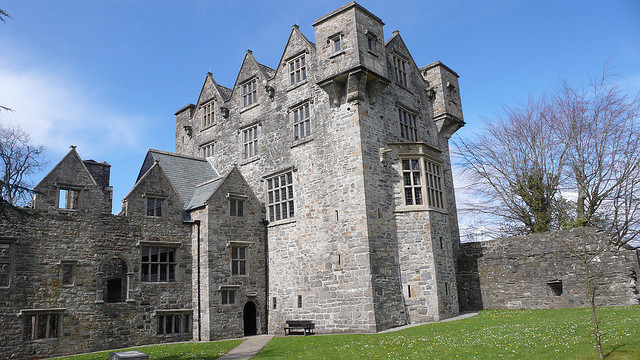

Location: Donegal Map
Constructed: 15th century
Donegal Castle or O'Donnells Castle is situated in a town of Donegal in the Donegal County in Northwest Ireland. Donegal Castle was constructed in the 15th century on the bank of the Eske river by Sir Hugh O'Donnell and his wife Nuala. They were elders of the O'Donnell clan, noble Gaelic family that ruled this region from 5th to the 16th centuries. A legend claims that a tunnel was also dug between the castle and the Franciscan monastery that was constructed by the same O'Donnell clan. In the early 17th century after the Nine Years war most of the O'Donell clan has left Ireland in an infamous Flight of the Earls. Inventive owners damaged theirs castle to prevent it from being used however new owners quickly rebuilt it and turned the former citadel into private chateau. New additions all involved a stone fence that surrounded the compound as well as new living quarters. Donegal Castle underwent a major restoration in the late 20th century.
The Irish name for Donegal Castle - Dun on n-Gall
is translated as “Alien Fortress”. Why the castle and the city got
such a name is not entirely clear. There is a version that the
Vikings once landed in this area and built their own fortress, which
was then destroyed in 1159. However, no archaeological evidence of
such a Viking fortress was found. According to another version,
these lands were once owned by the O’Galagher clan (Ir. O'Gallagher
O’Gallagher), which once helped the Vikings whose ship crashed off
these shores, and for this the Vikings never attacked these lands.
Sir Hugh O’Donnell the Elder, the wealthy leader of the O’Donnell
clan, built the castle here in 1474 At the same time, he and his
wife Nuala (Irl. NualaNuala) built a Franciscan monastery further
downstream. Local legend speaks of tunnels connecting the two
structures, but no evidence of this has been found. The castle was
considered one of the best Gaelic castles in Ireland. This is
evidenced by a report on a visit to the English Viceroy, Lord MP of
Ireland - Sir Henry Sidney, who in 1566, in a letter to William
Cecil - I Baron Burley, Lord Treasurer, described him as "the
greatest and strongest fortress in all of Ireland," adding: “This is
the largest castle I have ever seen in the hands of the Irish, it
seems to be in good condition, one of the most beautiful, located on
good ground and so close to drinking water that a boat of ten tons
can come ten yards away From him".
In 1607, after the end of the Nine Years War, when the last
independent kingdoms of Ireland fell, and the attempt to gain
independence for Ireland ended in yet another collapse, the
O’Donnell chieftain left Ireland during the so-called “Flight of the
Earls.” In 1611, the castle and its lands were donated to the
English captain Basil Brook. The castle was seriously damaged by the
O’Donnell clan, so that the new British owners could not use it to
fight against the Irish clans. But the new owners quickly restored
the castle. Captain Brooke added new windows, new pediments and
completed the Lord’s large new house, a wing to the watchtower, all
in the style of King James I. The Brooke family owned the castle for
many generations until it turned into a complete ruin in the 18th
century. In 1898, the then owner, Earl of Arran, donated the castle
to the Public Works Office in Ireland.
In the 1990s, the Public Works Office renovated the castle. A new
roof and floors were installed using original styles and techniques
of the 15th century. Oak wood materials were brought from
Brookenbrow Estate, Ferman County. The castle is currently open to
the public and often hosts events such as Gaelic cultural evenings.